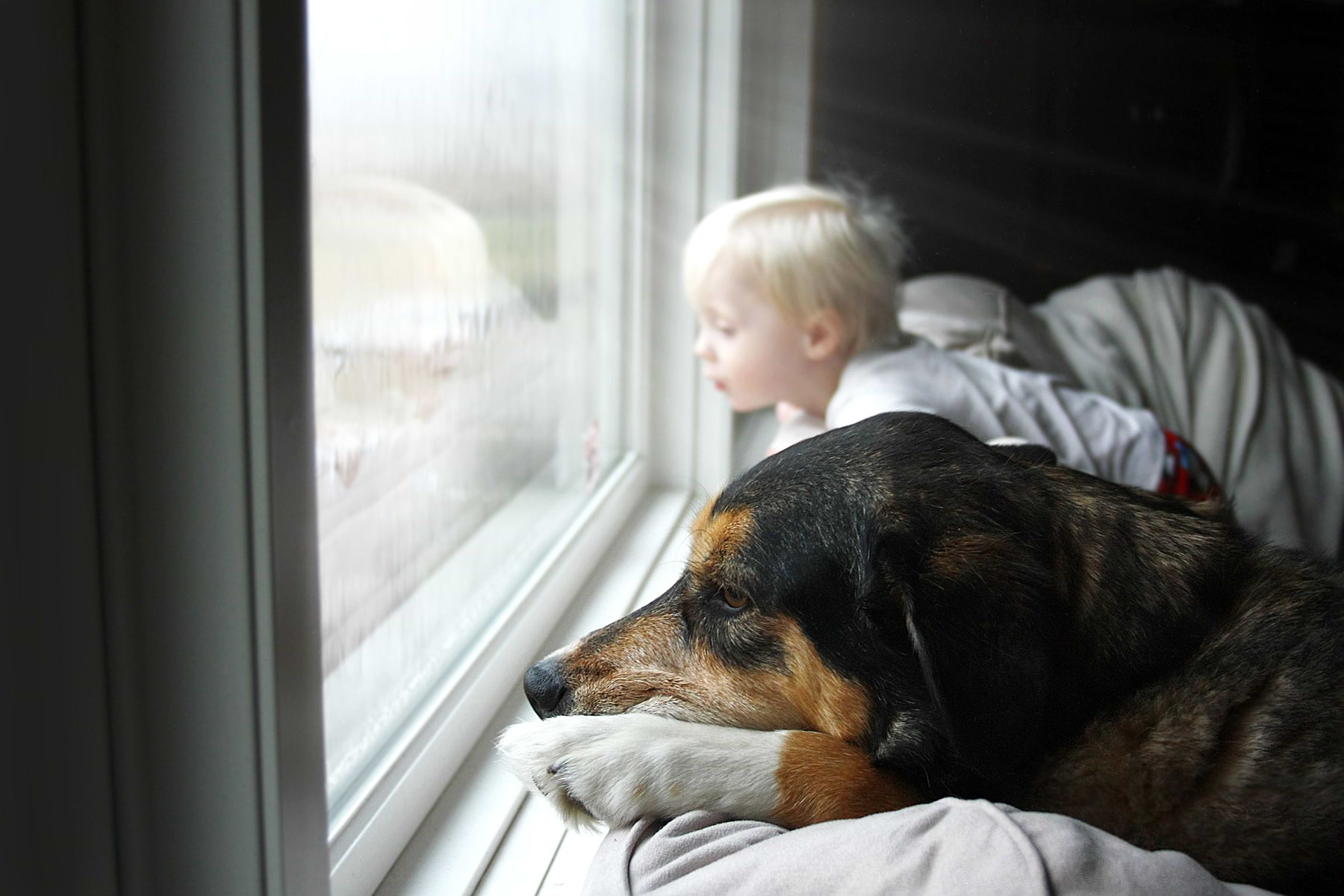Is your household chaotic when a storm rolls through? Or does it become eerily quiet with your pups hiding under the couch? Storm anxiety in dogs is real. Fear not, though. There are plenty of ways you can help your terrified canine companion while mother nature does its thing. Read on for a guide on how you can manage your pet during a thunderstorm.
Where Does Storm Anxiety Come From?
Keep in mind that storm anxiety is normal, so there’s definitely nothing wrong with your pet. While it’s common, it does feel very real for your pup and it’s important to take them seriously. If you have a dog that becomes super anxious when a storm rolls through, you’ll want to alleviate that stress as much as possible and make them feel safe during the process.
Think of storm anxiety as a phobia. Just as humans have certain fears, so do canines. Maybe your dog had one terrible storm experience, and now they have crippling anxiety any time thunder appears in the distance. Or maybe your dog just doesn’t like loud noises, and thunderstorms make them shake. Whatever the case, your dog is afraid. Plain and simple.
The Severe Weather Itself
Specialists believe that storm anxiety comes from the combination of loud noises paired with barometric pressure changes and a low-frequency rumble that occurs before the storm. There are also theories that dogs experience minor shocks from static buildup.
More Sensitive Ears
Innately, dogs have more sensitive ears than humans do. Maybe your dog is just more sensitive to loud noises in general. If your dog is afraid of thunderstorms, they are probably also afraid of fireworks, your blender, and other similar noises.
The Pet Parent’s Energy
Dogs are consumers of the energy around them. If the pet parent is fearful of storms, there’s a good chance that their pet is going to be fearful as well. That’s why it’s important to remain relaxed and upbeat during the downpour.
Breed and Personality
Genetic predisposition plays a role in how anxious your dog is. Some dogs are more stressed-out than others. This could be associated with their breed, age, and personality.
Lack of Understanding
It’s possible that your dog just doesn’t quite get it. They’re hearing surround sound noises coming from every which way and might just feel threatened. It’s instinctual (in humans too) to dislike loud noises and to want to seek shelter when they happen.
Stopping Storm Anxiety in Its Tracks
If you have a puppy, there are some preventative steps you can take to keep them from developing a fear of storms. For one, teach your dog basic commands so when a storm does occur, they are able to obey. Practice these basic commands on a sunny day so that when a storm does hit, your pup will still be able to come, sit, lie down, and stay.
Introduce your puppy to interactive toys. When the storm rolls through, give your puppy the interactive toy with the hopes that it will keep them busy. This interactive toy should incorporate a high-value treat—something that your puppy adores and that will keep them fixated for a while. They’ll forget there’s any storm at all!
During your puppy’s first thunderstorm, associate the event with positivity. Maybe that means you start playing with your pup as soon as the booms start. You can also turn up the television and relax with them.
Have treats on hand. Make sure you’re giving your puppy their favorite chews or bones. Consider this a time for extra love so the next time there is a storm, your puppy will respond to it as a predictor of something good.
What Dog Body Language Reveals
Pay attention to your dog’s body language during a storm, as it will tell you a lot. Your dog might start panting, whining, or yawning uncontrollably. You might notice that they become anxious, hyperactive, or hide under the couch.
Clinginess and attention-seeking are two additional ways that dogs might attempt to communicate their anxieties when a storm hits. Below is a list of potential changes in your dog’s body that indicate storm anxiety.
- Trembling/Shaking
- Panting paired with drooling
- Lowered ears and tail
- Wide eyes
- Howling
- Urinating or defecating in the house
- Clawing
- Destructive Behavior
- Excessive Barking
Sometimes these fears and anxieties manifest into full-blown panic attacks, which could be very dangerous for your canine companion. There’s potential for them to become so scared that they run away or claw your furniture. Keep a close eye on your pet at all times during these high anxiety moments.
How To Handle Storm Anxiety
There are things you can do before and during a storm to help relieve your dog’s storm anxiety. Bear in mind that reversing certain habits and kicking fears is not easy and will take time, patience, and consistency. Punishing or harshly scolding your pup will not help.
Before
When you know that a storm is coming but your pet is still calm, load up on treats, toys, favorite beds and blankets, games, and verbal praise. Get your dog going but in a positive way.
You can also use the method of desensitization prior to a storm. If it’s Tuesday and you know there is going to be a storm on Friday, take this method into consideration. Desensitization is the process of exposing your pet to a stimulus that would normally cause a negative reaction, like fear. Play a recording of storm noises on low volume and simultaneously shower your dog with the love mentioned above; treats, chews, interactive toys, etc.
After some time, increase the volume of the recording while maintaining the positive reinforcement. This should be a gradual process. The downside to this particular method of desensitization is that it’s only a solution for loud noises. While it’s great to nip that piece in the bud, there is more to storm anxiety than just that, like barometric pressure drops and static electricity.
During
Use the crate as a tool to manage your pup during a thunderstorm. You’re essentially giving your pup a retreat—a comfortable safe haven that will make them feel more at ease. Invest in a durable crate that suits your canine. Prep it with an orthopedic crate pad or a plush blanket for extra snugness.
Equip the space with their favorite chew or a crate training aid that incorporates something delicious, like peanut butter. There is a good chance this setup will make your dog feel safe and secure.
If you don’t want to put your dog in a crate during a thunderstorm, you can close off a large space for them, like a bathroom or a playpen. Again, prep the space with comforting items like blankets and chews, food, and water.
During the storm, you can dress your dog in a wrap, as there are clothing items for dogs that are specifically made for thunderstorms. They’re known to provide comfort during times of stress and fear. These specialized jackets are meant to swaddle your pup, which gives them a sense of security and peace of mind.
Lastly, engaging in playtime during the storm is a great way to distract and an effective way to tell your pup that “Everything is okay!” Put on some music or turn on the fan to drown out the rumbles.
Medication and Help From a Specialist
There are medications you can give your pup that will help them get through these moments of high stress and anxiety. These medications should come prescribed by your vet. They’ll be able to properly identify what your dog needs according to their type of anxiety, breed, age, and genetics.
In addition to that, many pet parents have reported success in using CBD oils for pet stress. This could be an option for your dog as well. Note again that nothing should be given to your animal until you’ve spoken to a doctor, as there is no scientific data proving that CBD affects your dog one way or another.
Conclusion
To conclude, let’s run through everything that we’ve covered thus far. When dealing with a storm and a highly anxious dog, understand the root of the stress. Not only are dogs sometimes sensitive to loud noises, but when a thunderstorm rolls through, there are barometric pressure changes as well as low frequency rumbles that humans are not able to hear. In addition to that, there is the static build-up that your pet can feel.
If you have a puppy, there are preventative measures you can take to stop storm anxiety in its tracks. Desensitization and positive reinforcement are two methods you can try to avert their anxieties when a storm approaches.
Take note of your dog’s body language when the sky starts to gray and lightning strikes. You may notice changes in their ears, eyes, and tail, shaking, barking, and hiding, among other visible changes in their demeanor. This is a sure sign of storm stress.
We also discussed what you can do before and during a storm. Before the storm hits, load your pup up on their favorite things: toys, treats, and games. Desensitize using pre-recorded storm noises that you have control over. Start with a low volume and gradually increase until your dog is unphased. Of course, the process of desensitization takes time and should be practiced days or weeks before.
During the storm, try utilizing the crate or another enclosed space that your pet will feel secure in. The goal is to give them a place where they feel safe and snug. You can also invest in a storm jacket or wrap, as they are known to ease anxieties as well.
If all else fails, consult your dog’s doctor on anti-anxiety medication or similar solutions to find what is right for your pet. Ultimately, the goal is to properly communicate your empathy and give your pet the right kind of love so their storm anxieties subside and they can be their happy little selves again.
Sources:
Canine Storm Anxiety | Pet Health (a division of Avrio Pharmacy)
Dog Thunderstorm Anxiety | American Kennel Club
Dog Anxiety: What Dog Owners Need to Know | American Kennel Club

The Diggs Team
We believe our dogs deserve safer, better designed pet products.
You might also like
Crate training tips, stories and inspiration
View all blogsIn Your Diggs
Share your photos with #DiggsPet and tag us @DiggsPet on IG and TikTok.



